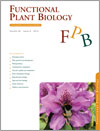
Functional Plant Biology
Volume 39 Number 8 2012
FP12195From landing lights to mimicry: the molecular regulation of flower colouration and mechanisms for pigmentation patterning
The staggering variety of flower colours and flower colour patterns found in nature has arisen as a mechanism for plants to communicate with potential pollinators. This article reviews the occurrence, function and control of flower colour patterns, and presents models on how patterns form. Such patterns provide elegant examples of spatial regulation of gene expression in plants.
FP11289Rapid adjustment in chrysanthemum carbohydrate turnover and growth activity to a change in time-of-day application of light and daylength
Diurnal leaf carbohydrate turnover patterns are complex and vary in relation to species, developmental stage and environmental conditions. We demonstrate rapid adjustment of carbohydrate turnover and leaf growth to a phase-shift in light conditions in Chrysanthemum. The starch pool confers a high buffer capacity to maintain sugar supply for growth and explains the direct relationship between growth and daily light integral in fluctuating light environments. The results are valuable in describing non-model plant species responses to ever-changing light environments.
FP12071Grapevine rootstock effects on scion biomass are not associated with large modifications of primary shoot growth under nonlimiting conditions in the first year of growth
Grafting is widely used in horticulture and rootstocks are often selected to alter scion biomass, yet we have little knowledge of how rootstocks alter scion development. In this work, we dissected rootstock-conferred vigour into variables of primary growth, which were only marginally affected by the rootstock genotype. The duration of growth was the variable most affected by rootstock genotype, suggesting that carbon balance may contribute to rootstock induced differences in scion biomass.
FP12047Light sensitivity of shoot hydraulic conductance in five temperate deciduous tree species
The adjustability of the conductance of leaves to water flow is important as it enables the maintenance of optimal water content in leaves and thereby high photosynthetic rate and production of plants in a changing environment. We found that light increases shoot hydraulic conductance most strongly in tree species with conservative water use, and that blue light is most efficient in increasing this conductance. Thus, the enhancement of shoot hydraulic conductance by blue light is an important mechanism enabling trees to use soil water resources conservatively (economically).
FP12094Developing controlled environment screening for high-temperature tolerance in cotton that accurately reflects performance in the field
Improving the heat tolerance of cotton genotypes may increase yield for crops grown in warm or hot seasons. The cell membrane integrity assay was used to detect genotypic differences in heat tolerance and these differences were consistent with higher order physiological performance and underlying gene expression under elevated temperatures. Physiological assays may be used to initially screen large populations for heat tolerance when supported with a multi-level approach to deliver genotypes with superior economic yield under hot environments.
FP12059Serpentine tolerance in Mimulus guttatus does not rely on exclusion of magnesium
The physiology of plants adapted to the low Ca:Mg ratios of serpentine soil is not well defined. We assessed adaptation to low Ca:Mg ratios in Mimulus guttatus, measured as differences in biomass accumulation, Ca and Mg tissue content and photosynthetic rates, and found that tolerance to serpentine soil in these populations does not depend on the exclusion of magnesium. This implies that the mechanism for tolerance relies on maintaining the intracellular balance of Ca: Mg.
FP12152Seasonal and multiannual effects of salinisation on tomato yield and fruit quality
Agricultural productivity must increase to feed a world of 9 billion people by 2050. However, farmlands are increasingly exposed to degradation phenomena associated with climate change and current agricultural practices. It is estimated that of over 270 million ha of irrigated land, nearly 20% is salt affected. In this study we addressed the often overlooked effects of long-term salinisation on tomato yield and we identified crop traits that should be potentiated to counteract the impact of salinisation in agriculture.
FP12109Tolerance responses of Brassica juncea to salinity, alkalinity and alkaline salinity
Despite their frequent co-occurrence in natural soils, salinity and alkalinity are rarely considered together when assessing stress tolerance in plants. We investigated the effects of these stresses in juncea canola and established that a mild but prolonged combined stress greatly reduced growth of salt tolerant genotypes. Findings of this study will help selection and breeding for tolerance to a common but previously poorly understood stress.
FP12095The vacuolar Na+–H+ antiport gene TaNHX2 confers salt tolerance on transgenic alfalfa (Medicago sativa)
A vacuolar Na+/H+ antiporter gene TaNHX2 overexpressed in alfalfa and improved its salt tolerance. To address the mechanism, our results showed that increased salt tolerance was attributed to improved membrane protection, osmotic adjustment, plant K+ nutrition and more Na+ compartmentation in vacuoles, and that TaNHX2 gene may be involved in H+-linked K+ exchange. The transgenic germplasm will be of great application prospect in alfalfa breeding for salt tolerance.




